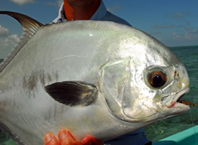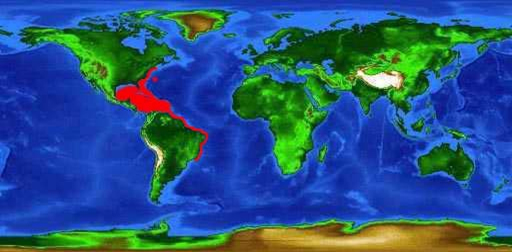Order – Perciformes
Family – Carangidae
Genus – Trachinotus
Species – Falcatus
Taxonomy
 Carolus Linnaeus originally described the permit in 1758, classifying it within the jack family carangidae. He initially named it Labrus falcatus, but later taxonomists reclassified the permit within the genus Trachinotus, grouping it with similar species such as the Florida pompano (Trachinotus carolinus), the palometa (Trachinotus goodei), and the blackblotch pompano (Trachinotus kennedyi). Though the permit has been confused as all of these fish, Trachinotus falcatus serves as the only valid scientific name for the species. Falcatus, a Latin adjective that translates to “armed with scythes,” appropriately describes the large sickle-shaped dorsal fin that breaches the surface when permit feed.
Carolus Linnaeus originally described the permit in 1758, classifying it within the jack family carangidae. He initially named it Labrus falcatus, but later taxonomists reclassified the permit within the genus Trachinotus, grouping it with similar species such as the Florida pompano (Trachinotus carolinus), the palometa (Trachinotus goodei), and the blackblotch pompano (Trachinotus kennedyi). Though the permit has been confused as all of these fish, Trachinotus falcatus serves as the only valid scientific name for the species. Falcatus, a Latin adjective that translates to “armed with scythes,” appropriately describes the large sickle-shaped dorsal fin that breaches the surface when permit feed.
Geographical Distribution
Permit inhabit the western Atlantic from Massachusetts to southeastern Brazil. They occur throughout the West Indies and the Gulf of Mexico, and less-frequently in Bermuda. The species has been reported in the eastern Atlantic, but does not regularly occur there. The species is most abundant in southern Florida.
Habitat Permit primarily occupy inshore regions such as flats and sandy beaches, and deeper cuts, channels, and holes adjacent to these areas. The substrate of the flats may vary from sand, mud, marl, or sea grass. Permit often swim in water depths less than 2 feet, though due to large body depth, large individuals cannot occupy waters as shallow as other flats species such as bonefish. In deeper waters up to 30 m, permit often congregate around structures such as reefs, jetties, and wrecks where they frequently occur in large schools.

Biology
Distinctive Features
The deeply forked tail and elongated anterior dorsal fin provide the more distinct characteristics of the permit. Looking like long sickles, these fins impart the fish’s species name falcatus. However, one can also identify the permit by its highly laterally compressed body, making the fish appear thin and tall. From a lateral perspective, the permit shape looks round in juveniles, but becomes oblong as the fish ages into an adult. In addition to the long anterior dorsal fin, inserted directly above an elongated anterior anal fin, permit also possess 17-21 soft dorsal rays, and 16-19 soft anal rays.
Coloration
Permit have bright silver sides and bluish-green or brown backs. The belly will sometimes show yellow or an occasional black splotch. The fins appear dark gray or black.
Dentition
Permit have no teeth other than granular teeth that occur on the tongue, designed for crushing mollusks and crustaceans. The teeth are most conspicuous in younger fish.
Size, Age & Growth
Permit reach a maximum length of at least 48 inches (122 cm) and a weight of 79 pounds (36 kg). They grow rapidly until an age of 5 years, at which point growth slows considerably. Permit reach sexual maturity at about 2.3 years for males, and 3.1 years for females. Their size at sexual maturity ranges from 19.1 inches (486 mm) for males and 21.5 inches (547 mm) for females. Permit can attain an age of 23 years, though they probably live longer. Other carangids, such as the Florida pompano (Trachinotus carolinus) and the white trevally (Pseudocaranx dentex), are known to reach ages of 7 and 49 years, respectively.
Food Habits
Permit primarily forage on flats and intertidal areas, entering shallow water on incoming tides from deeper adjacent channels and basins. They usually travel in schools of about ten, but may school in larger numbers; larger permit tend to be more solitary, feeding alone or in pairs. Permit also congregate around wrecks and other deeper-water structures. Like the bonefish, the permit uses its hard mouth to dig into the benthos and root up its prey. These food items usually consist of crustaceans and mollusks, which the permit crushes with its granular teeth and pharyngeal bony plates. However, as opportunistic feeders, permit will eat a variety of animals, including amphipods, copepods, mollusks, polychaetes, fish and insects. Developmentally, permit exhibit planktivorous feeding habits as juveniles, eating copepods, amphipods, mysids, larval shrimp, and fish. As they increase in size, permit begin to feed on benthic prey including mole crabs, coquin clams, flatworms, gastropods, and sessile barnacles. Larger adults feed on gastropods, sea urchins, bivalves, and crabs.
Reproduction
Permit spawning may last all year, but occurs primarily from May through June in the Florida Keys. Spawning peaks during these summer months, with extended spawning seasons occurring outside this main period and a decrease in spawning activity during the winter months. Researchers have found that permit may spawn over natural and artificial reefs or in near shore waters in the middle and lower Florida Keys. Males reach sexual maturity earlier than females, 2.3 versus 3.1 years, and at respective sizes of 19.1 inches (486 mm) and 21.5 inches (547 mm).
Parasites
Permit suffer from many parasites, including the branchial parasite Bicotylophora baeri, the intestinal parasite Serrasentis socialis, and trematodes from the genus Lobatostoma. When cultured together in fish farms, permit may become susceptible to bacteria such as Vibrio anguillarum and the dinoflagellate Amyloodinium ocellatum. The latter infests the skin and gills of the host, eventually causing death through toxins or by interfering with respiration.
Importance to Humans
Permit compose an important commercial fishery along with their close relative the Florida pompano. The permit commercial fishery yielded 10.4 metric tons in 2002, down from 68 metric tons in 2000. Florida landings comprised 100 percent of the catch in 2002. In response to possible over fishing, the Florida Wildlife Commission recently raised minimum size limits and decreased bag limits (see Conservation below). Originally interested in the related Florida pompano, fish farmers have only recently begun to experiment with the mariculture of permit, raising them in large near-shore pens for commercial sale. Sport fishers consider the permit an important game fish, and this fish, in addition to the bonefish and tarpon, supports a large charter boat fishing industry. Many anglers regard the permit as one of the most difficult game fish to catch, and consider a permit caught on fly the highlight of their angling achievements. Many fishing guides and anglers highly esteem the permit and release the fish unharmed. Most mortality attributed to human activity while sport fishing occurs from injuries incurred when being landed, such as “gut hooking” or sharks that take advantage of the hooked fish. Though conscientious anglers attempt to break the line, thereby releasing the permit from restraint when a shark is sighted, sharks occasionally leave the angler with only half a fish. Danger to Humans Permit pose no threat to humans, though ciguatera poisoning may result if eaten.
Conservation Status
After recent surveys in 2003, the Florida Fish and Wildlife Commission changed the Florida size and bag limits for permit, effective January 1, 2004. The FWC raised the minimum size limit from 10 inches to 11 inches for all fishermen (commercial and recreational), and decreased the recreational aggregate bag limit of permit and Florida pompano from 10 fish to 6 fish per person per day. The upper size limit remains at 20 inches, but with a provision that allows anglers to retain one fish over 20 inches in their daily bag limit. These changes are designed to allow more permit to reach sexual maturity and reduce overall landings. Though susceptible to over fishing, the World Conservation Union (IUCN) does not currently list the permit as an endangered or vulnerable species. The IUCN (a global union of states, governmental agencies, and non-governmental organizations in a partnership) assesses the conservation status of species.

